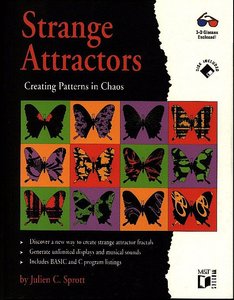
|
FreeComputerBooks.com
Links to Free Computer, Mathematics, Technical Books all over the World
|
|
- Title: Strange Attractors: Creating Patterns in Chaos
- Author(s) Julien Clinton Sprott
- Publisher: M & T Books; Har/Dis edition (September 1993); eBook(August 1, 2000)
- Paperback: 426 pages
- eBook: HTML and PDF (591 pages)
- Language: English
- ASIN/ISBN-10: 1558512985
- ISBN-13: 978-1558512986
- Share This:

|
This book describes a simple method for generating an endless succession of beautiful Fractal patterns by iterating simple maps and ordinary differential equations with coefficients chosen automatically by the computer. It contains over 350 examples of such patterns. Each pattern produces a corresponding piece of fractal music.
The book also describes methods for visualizing objects in three, four, and higher dimensions and explains how to produce 3-D stereoscopic images on the computer screen using red/blue glasses3d glasses which are included with the book.
About the Authors- Julien Clinton Sprott is an Emeritus Professor of Physics at University of Wisconsin, Madison, WI.
- Fractal Geometry and Fractals
- Geometry and Topology
- Differential Equations and Dynamical Systems
- Computer Graphics, 3D, Animation and Imaging

- Strange Attractors: Creating Patterns in Chaos (Julien C. Sprott)
- The Mirror Site (1) - PDF
- The Mirror Site (2) - PDF
-
 Fractals: Art to Applied Science (Benjamin Kenwright)
Fractals: Art to Applied Science (Benjamin Kenwright)
This text is a reference for learning and mastering Fractals (theoretical and applied perspective). It discuss how the fractal algorithms function, present code examples in editable sandboxes with explanations.
-
 Fractal Geometry: Mathematical Foundations and Applications
Fractal Geometry: Mathematical Foundations and Applications
This book has become a seminal text on the mathematics of Fractals. It introduces the general mathematical theory and applications of fractals in a way that is accessible to students from a wide range of disciplines.
-
 A Tale of Two Fractals (A.A. Kirillov)
A Tale of Two Fractals (A.A. Kirillov)
This book provides an original treatment of Fractals that is at once accessible to beginners and sufficiently rigorous for serious mathematicians. It is designed to give young, non-specialist mathematicians a solid foundation in the theory of fractals.
-
 Fractal Geometry (Mark McClure, et al.)
Fractal Geometry (Mark McClure, et al.)
Fractal geometry is a new way of looking at the world. This book combines text and graphics to offer the most accessible amount that any reader is likely to find, helping in the overall move toward scientific literacy.
-
 Fractals in Probability and Analysis (Christopher J. Bishop, et al.)
Fractals in Probability and Analysis (Christopher J. Bishop, et al.)
This is a mathematically rigorous introduction to Fractals which emphasizes examples and fundamental ideas. Building up from basic techniques of geometric measure theory and probability. Chapters are designed to be read independently.
-
 Conformal Fractals: Ergodic Theory Methods (Feliks Przytycki, ...)
Conformal Fractals: Ergodic Theory Methods (Feliks Przytycki, ...)
This is a one-stop introduction to the methods of Ergodic Theory applied to holomorphic iteration. Focus on the field of 1-dimensional holomorphic iterations and underlying Fractal sets, from the point of view of geometric measure theory and rigidity.
-
 Chaos and Fractals (Larry Bradley)
Chaos and Fractals (Larry Bradley)
This book provides the reader with an elementary introduction to Chaos and Fractals, suitable for readers with a background in elementary algebra, without assuming prior coursework in calculus or physics.
-
 Random Fractals (Peter Morters)
Random Fractals (Peter Morters)
Random Fractals are the method of choice when it comes to modelling landscapes, clouds and other natural phenomena. Describes the fundamentals of random fractals and some of the basic methods for their generation.
-
 The Fractal Geometry of Nature (Benoit Mandelbrot)
The Fractal Geometry of Nature (Benoit Mandelbrot)
Explore the wondrously complex repeating shapes of the natural world in The Fractal Geometry of Nature. Written in a style that is accessible to a wide audience, computer scientist, professor, mathematician, etc.





